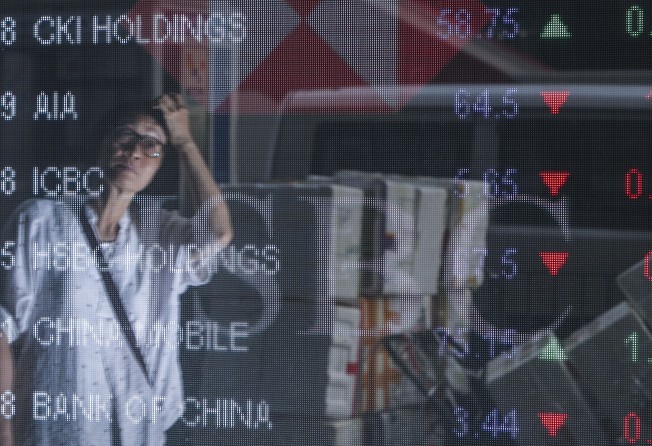
Why emerging markets will continue to feel the pain, even though they are not in crisis mode yet
Nicholas Spiro says while emerging market stocks have taken a beating, bonds have been fairly resilient. Investors waiting for bond prices to drop, however, will put strains on developing economies that could spread to the US

For a few days last week, the fierce sell-off in emerging markets appeared to be easing a tad. Yet by the end of this week, the strain on the asset class was showing no sign of letting up.
Several new milestones have been reached in the past several days alone. Last Friday, the rupee, India’s currency, breached the 72 mark against the US dollar for the first time – a fresh all-time low – while the Russian rouble dropped to its weakest level since March 2016. On Tuesday, Hong Kong’s equity market slipped into bear market territory, dragged down by the rout in technology stocks and concerns about China’s slowing economy.
According to a report by JPMorgan published last Friday, the MSCI Emerging Markets Index, the benchmark equity gauge for developing economies that is down 21 per cent from its peak in late January, is pricing in a “material slowdown” in global growth from the current rate of roughly 3.5 per cent to 2.5 per cent, revealing the extent of the bearishness in emerging market stocks.
The severity and protraction of the sell-off has sparked a debate among international investors over whether emerging markets present a compelling buying opportunity.

Stocks are unquestionably much cheaper than at the start of this year. Even Asian shares, which are pricier than other emerging market equities, are trading below their average levels over a 10-year period, having just suffered their longest sell-off since 2002, according to Bloomberg.
The JPMorgan report also notes that the gap in the forward price-to-earnings ratio, a popular valuation tool, between emerging market stocks and their expensive US peers is currently “one of the largest on record” and wider than the difference during the 2008-09 global financial crisis.
What is more, many emerging market currencies look oversold. Leaving aside the Turkish lira and the Argentine peso, which have been in free fall for several months, a significant number of developing economy currencies – in particular the South African rand, the Philippine peso and the Malaysian ringgit – are trading more than 10 per cent below their long-term average levels in real effective terms, the JPMorgan report notes.

Yet, when it comes to government and corporate bond markets – a more reliable gauge of underlying investor sentiment – the selling pressure has been much less severe.
While emerging market bonds have repriced over the past several months, the sell-off has been quite contained compared with previous bouts of turmoil. According to Bloomberg, spreads, or the risk premium, on dollar-denominated emerging market sovereign bonds are trading slightly below their average levels since 2010 and remain significantly below their levels during the last major China-induced sell-off in January 2016 and at the height of the “taper tantrum” in June 2013.
Emerging market corporate bond markets have proved even more resilient. Data from JPMorgan reveals that spreads on the bank’s benchmark Corporate Emerging Market Bond Index have risen less than 20 basis points in the past three months, with spreads on investment-grade dollar-denominated corporate debt even declining slightly.
This is the starkest evidence that emerging markets are far from entering a full-blown crisis.

Yet it is also proof that developing economies are still not cheap enough to entice buyers back and could be in for more pain in the coming weeks if sentiment continues to deteriorate and the selling pressure shifts from local currency debt – which has borne the brunt of the sell-off in bond markets this year – to better performing hard currency bonds where investors still hold overweight positions, according to a recent client survey by JPMorgan.
Emerging markets are facing the worst of both worlds right now: the strain on the asset class is increasing amid concerns about financial contagion, yet bonds are still expensive
Emerging markets are facing the worst of both worlds right now: the strain on the asset class is increasing amid concerns about financial contagion, yet bonds are still expensive, increasing the scope for further outflows and price declines.
The predicament has become more acute in the past week because of the sudden shift in US interest rate expectations following last Friday’s publication of data showing wages growing at their fastest pace since 2009. Bond markets are now pricing in two additional rate hikes this year, providing further impetus to the hawkish shift in US monetary policy that is underpinning the surge in the dollar, the main headwind for emerging markets.
Still, the greater the strain on developing nations, the bigger the risk that advanced economies, in particular America, will start to feel the effects of the turmoil, especially if the trade war escalates further.
Emerging market asset prices may need to fall further to tempt buyers back, but a sharper sell-off could puncture the optimism surrounding US markets. Investors waiting for cheaper valuations in developing economies should be careful what they wish for.
Nicholas Spiro is a partner at Lauressa Advisory